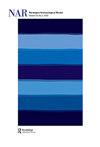青铜时代的创造力。理解陶器、纺织品和金属制品生产中的创新
IF 1.1
3区 历史学
0 ARCHAEOLOGY
引用次数: 0
摘要
这本合作撰写的书(Lise Bender Jørgensen、Joanna Sofaer和Marie Louise Stig Sørensen,Grahame Appleby、SebastianBecker、Sophie Bergerbrant、SarahCoxon、Sølvi Helene Fossøy、Karina Grömer、Flemming Kaul、Darko Maricevic、Sanjin Miheli、Antoinette Rast Eicher和Helga Rösel Mautendorfer的贡献)探讨了欧洲青铜时期创造力的本质通过观察陶器、纺织品和金属制品这三类重要物品的发展来了解时代。该卷介绍了一系列创新主题,重点是物质性、美学、训练和学习、宇宙学以及技术变革和创新。这个话题的重要性和兴趣非常广泛。近年来,考古学科受到更多考古数据、新的刺激性理论和自然科学探索考古项目的新方法的推动。然而,这些发展往往被划分在每个发现类别中,在学术讨论中很少相互关联。这本书的巨大优点在于,它以一种全面的方式将陶器、金属制品和纺织品这三个类别结合在一起,让读者能够真正看到各种工艺的发展和共同点。整体设计、结构和组织有力地加强了整个研究项目的跨学科性,使该卷成为一本极具刺激性的读物。它分为三个部分。每一部分都由一篇关于纺织品、陶器或金属制品的特定案例研究或主题的个人或合著论文组成,在每一部分中,三位主要作者首先介绍主题,并通过思考得出结论。在第一部分:原材料:创造力和材料的性质中,考古调查与自然科学的新分析方法相结合;第二部分:生产实践借鉴了实验考古学和社会人类学的研究成果;第三部分:效果:形状、主题、图案、颜色和纹理,强调并讨论了特定的特征,如某些重复出现的主题及其潜在的宇宙学意义,或装饰效果及其技术解释。这本选集中的研究源于一个HERA项目,该项目由欧盟委员会的创意欧洲在竞争激烈的国际电话会议上授予,并由专家进行同行评审。这也是这本书的一个伟大品质,因为它不仅仅依赖于偶尔的合作或会议;几年来,作者们在一个共同的项目中合作,这使本书及其结论相当成熟,并形成了一部简洁连贯的作品。这本书的成就在于,它真正将跨学科性嵌入了书的结构、每一章,甚至每一节的引言中。它是由三位编辑和许多专家作者在持续的对话和讨论中共同撰写的文本。在太多的合作项目中,目的是跨学科分享知识和工作,但在最终出版物中,每个学者都写下了自己的章节。这里的情况并非如此。即使是在单独撰写的章节中,也有很大的努力将结果和想法纳入理解所有三个领域创造力的整体范围,而不仅仅是在相似性和差异性方面。例如,在陶器和纺织品专家(Joanna Sofaer、Sarah Coxon、Karina Grömer、Sanjin Miheli)合著的关于Litzenkeramik的一章(第275–284页)中,这种一致的整合确实令人印象深刻。他们调查了本文章由计算机程序翻译,如有差异,请以英文原文为准。
Creativity in the Bronze Age. Understanding Innovation in Pottery, Textile, and Metalwork Production
This collaboratively written volume (Lise Bender Jørgensen, Joanna Sofaer, and Marie Louise Stig Sørensen, with contributions by Grahame Appleby, SebastianBecker, SophieBergerbrant, SarahCoxon, Sølvi Helene Fossøy, Karina Grömer, Flemming Kaul, Darko Maricevic, Sanjin Mihelic, Antoinette Rast-Eicher, and Helga Rösel-Mautendorfer) explores the nature of creativity during the European Bronze Age by looking at developments in three significant categories of objects: pottery, textiles and metalwork. The volume introduces a series of innovative themes focusing on aspects of materiality, aesthetics, training and learning, cosmology, and technological change and innovation. The importance and interest of the topic are very broad. The discipline of archaeology is in these years fuelled by more archaeological data, by new stimulating theories, and by newmethods from the natural sciences to explore the archaeological items. However, these developments are often compartmentalised within each find category, and are rarely related to each other in scholarly discussions. It is to the volume’s great merit that it combines the categories pottery, metalwork and textiles in such a comprehensive way that the reader can truly see the developments and communalities across crafts. The overall design, structure and organization strongly strengthens the cross-disciplinarity of the entire research project, and makes the volume an extremely stimulating read. It is divided into three parts. Each part consists of an individual or coauthored papers on very specific case studies or topics of textiles, pottery or metalwork, and in each part, the three main authors first introduce the theme and conclude by reflections. In Part I: Raw materials: Creativity and the Properties ofMaterials, archaeological investigations are combined with new analytical methods from the natural sciences; Part II: Production Practices draws in research from experimental archaeology and from social anthropology;Part III: Effects: Shape,Motifs, Pattern, Colour, and Texture, highlights and discusses specific features such as certain recurring motifs and their potential cosmological meaning, or decorative effects and their technical explanations. The research in this anthology stems from a HERA project, awarded by the Creative Europe of the EUCommission in a highly competitive international call and peer-reviewed by experts. This is also a great quality of the book, because it does not simply rely on an occasional collaboration or a conference; the authors have worked together in a shared project for several years and this has matured the book and its conclusions considerably, and has resulted in a concise and coherent work. The achievement of the volume is that it has truly embedded interdisciplinarity in the structure of the book, in each chapter, even into the introduction of each section. It appears as a text written conjointly, by the three editors and the many expert authors in a continual dialogue and discussion. In too many collaborative projects, the intentions are to share knowledge and work across disciplines, but in the final publication, each scholar writes his/her own chapter. This is not the case here. Even in the single-authored chapters, there is a strong effort to incorporate results and ideas in the overall scope of understanding creativity in all three fields, and not just in terms of similarities and differences. This consistent integration becomes very impressive indeed in, for example, the chapter (p. 275–284) onLitzenkeramik, co-authored by experts on pottery and textiles (Joanna Sofaer, Sarah Coxon, Karina Grömer, Sanjin Mihelic). They investigate how this
求助全文
通过发布文献求助,成功后即可免费获取论文全文。
去求助
来源期刊

Norwegian Archaeological Review
ARCHAEOLOGY-
CiteScore
2.10
自引率
0.00%
发文量
13
期刊介绍:
Norwegian Archaeological Review published since 1968, aims to be an interface between archaeological research in the Nordic countries and global archaeological trends, a meeting ground for current discussion of theoretical and methodical problems on an international scientific level. The main focus is on the European area, but discussions based upon results from other parts of the world are also welcomed. The comments of specialists, along with the author"s reply, are given as an addendum to selected articles. The Journal is also receptive to uninvited opinions and comments on a wider scope of archaeological themes, e.g. articles in Norwegian Archaeological Review or other journals, monographies, conferences.
 求助内容:
求助内容: 应助结果提醒方式:
应助结果提醒方式:


